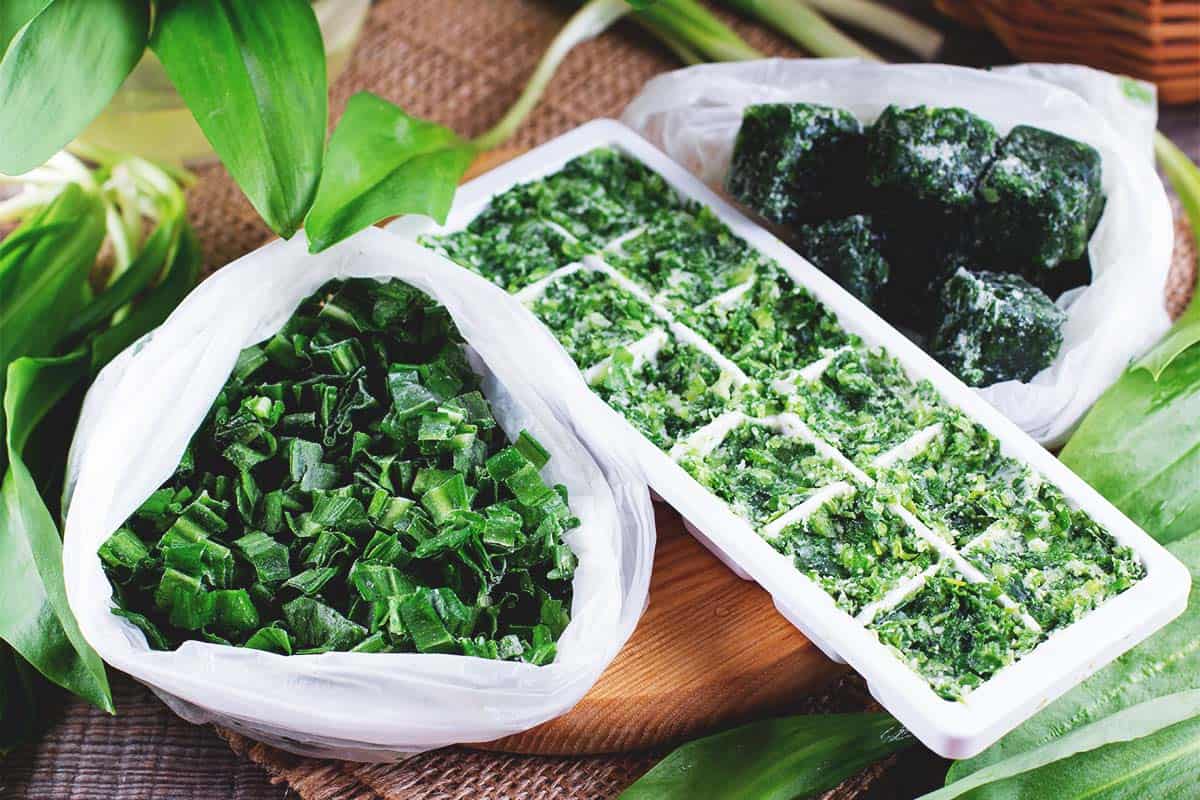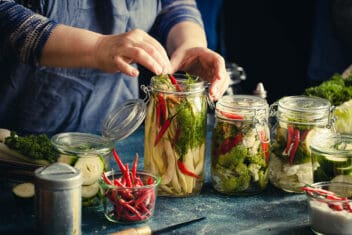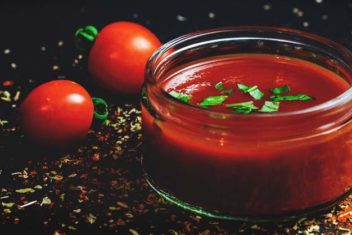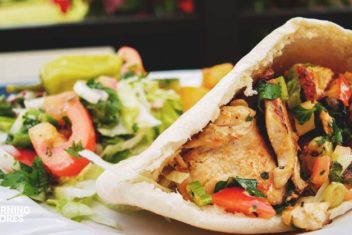There’s nothing I love more than walking out to the garden on a hot summer afternoon and clipping a few sprigs of fresh basil to use in my cooking.
Unfortunately, in the dead of winter, the days of barefoot strolls in the summer sun are out of the question. So are fresh herbs, in many cases.
Although there are plenty of herbs that can be grown indoors over the winter months, I have always found that there is a limit to how many plants I can grow inside. I’m limited by both space and time!
Luckily, freezing herbs extends the glory of summer long into the winter months. Once picked, herbs begin to lose their flavor and potency rapidly. However, you can extend the shelf life of your favorite herbs by freezing them.
Many people rely solely on dehydrating as a method of preserving their summer herbs. However, it doesn’t always capture the flavor as well as you might like. There are some herbs that have a lot of moisture, like parsley and mint, that don’t dehydrate as well, either.
Frozen herbs are the perfect alternative if you’re fresh out of – pun intended – fresh herbs. They offer the same nutrients and almost an identical taste. While they might not look great as garnishes, frozen herbs are just as delicious in foods. They also allow you to extend your harvest for many months.
If you want to enjoy a bounty of herbs in your cooking all year long, consider these tips for using them in your cooking. I’ll also tell you which herbs freeze best and how exactly to do it!
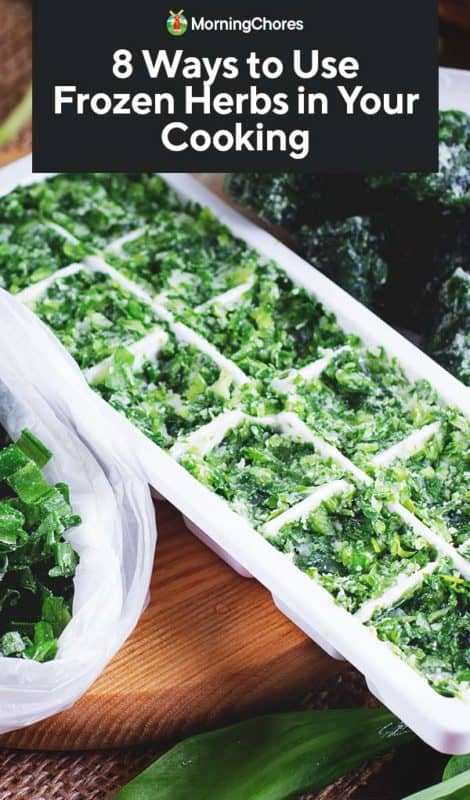
How Can You Use Frozen Herbs in Your Cooking
1. Substitute for Fresh
Nine times out of ten, you’ll be able to use frozen herbs as a direct substitute for fresh herbs in your cooking. In some cases, you won’t even have to thaw the herbs! Simple sprinkle or toss them as needed into your recipe.
Just avoid using herbs that have been frozen as garnishes, because you’ll likely be disappointed by the (somewhat soggy) results.
2. Sprinkle Over Hot Foods
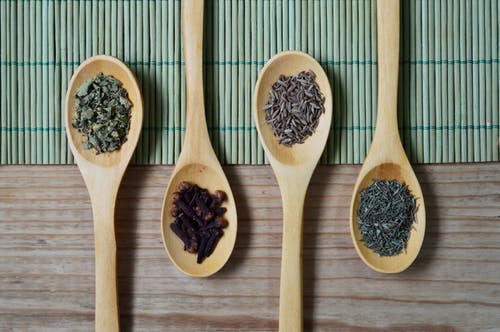
Just like you would normally sprinkle fresh tarragon, parsley, or chives over your favorite hot dishes – like scrambled eggs, rice, or cooked chicken – you can also sprinkle frozen herbs over them, too.
Keep in mind that this method works best if you have frozen herbs by themselves and not with any water or oil.
3. Make Herbal Rubs
You can easily make rubs with your preserved herbs, too. Again, plain herbs will work best for this, as will those that have already been chopped. Simply rub them onto the perfect cut of pork chop or roasted chicken before cooking. You likely won’t even remember that they were previously frozen when it’s time to eat.
4. Liven Up Bread Dough
If you’re sick of the same old homemade bread, why not add a few herbs to spice things up? A great artisan loaf can be improved with a dash of rosemary or basil. Both of these herbs freeze remarkably well. You can make your own blend or just try one or two different herbs at a time. You can even use frozen herbs in a quiche crust!
5. Make Herb Butter
Herb butters are all the rage. From chive butter to lavender butter, you can really upgrade your normal buttered toast experience when you use frozen herbs. You may want to thaw them for this application. This will get rid of unwanted, excess moisture in your butter (the moisture won’t cookout as it would in a hot dish).
6. Salads
For cold salads, thaw your herbs before using them. You can use plain thawed herbs or you can make a bottled vinaigrette for your salad greens – just whisk some dill or tarragon into a bit of vinegar. You don’t have to stick to green salads either. Frozen herbs taste great in egg, potato, and tuna salads, too.
7. Sauces
If you’re experimenting with using frozen herbs in the kitchen, a sauce is a great place to start. If there are any flavors or textures that you don’t like, it will be easy to conceal the mistake by adding other ingredients.
You don’t have to thaw herbs before putting them in a sauce – just make sure you stir constantly while they are cooking.
8. Desserts
Even desserts can get an upgrade with some frozen herbs! Depending on what exactly you are making, you may (or may not) want to thaw your herbs first.
Which Herbs Can Be Frozen?
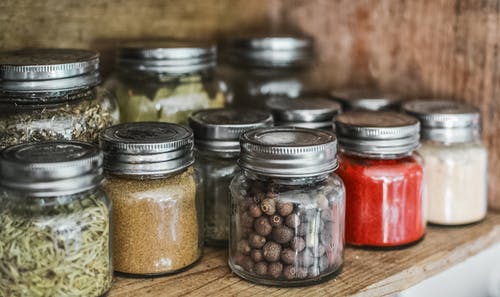
You can freeze just about any type of herb you want, but there are some that hold up better than others.
While fresh is almost always preferred to frozen or dehydrated herbs, the following herbs all retain their flavor better when they are frozen than when they are dried:
- Tarragon
- Fennel
- Basil
- Dill
- Parsley
- Chives
- Sage
Some other herbs that freeze well include borage, lemongrass, oregano, mint, savory, sorrel, thyme, and sweet woodruff.
Ultimately, just about any herb can be frozen – but think carefully about how you intend to use the herbs after thawing to decide which ones are best suited for this preservation technique.
Further Tips for Using Frozen Herbs
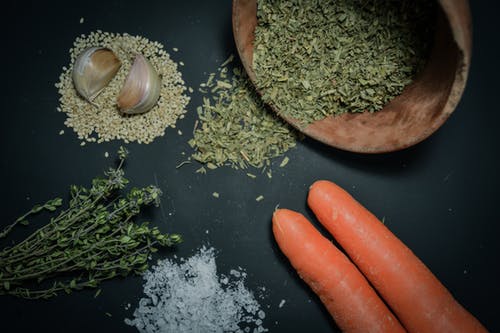
1. Consider Your Dish
Whenever you are using frozen herbs, you will want to consider the type of dish you are preparing and whether frozen herbs are best. When it comes to garnishing, fresh herbs are really going to be ideal. Frozen herbs will be limp and somewhat soggy.
Frozen herbs, however, can be used as long as you have time to stir and cook the herb into the recipe for a few minutes.
2. Think About Blanching
Many herbs benefit from a quick blanching before they are frozen. These include mint, chives, tarragon, fennel, and parsley. They will not only retain their color better, but they’ll likely taste better after they’ve been blanched, too, as it slows the breakdown of compounds in the plant.
To do this, you will want to tie together a small bundle of sprigs or stems with kitchen twine. Dip the bundle into boiling water for just ten seconds, then plunge it into ice water. Resist the urge to let the bundles sit in ice water for a prolonged period of time – you really only want to leave them in there until they are barely cool to the touch.
Shake off the excess water and dry the herbs gently with paper towels. Then, you can proceed to freeze them as normal.
3. Only Freeze the Best
As with all other methods of food preservation, it’s important that you only freeze the very best herbs. You should avoid using those that are already limp or discolored when you harvest them, as well as those that have any visible signs of damage. They simply won’t freeze as well as healthier herbs.
4. Store and Label Smartly
When you’re freezing herbs – as well as all other types of foods – it’s important for you to think about the containers in which you will freeze them. The best options include plastic freezer bags, freezer-safe containers, and glass jars with tight-fitting lids. You can also use canning jars or vacuum-sealed bags.
Make sure you label your herbs, too. There’s nothing worse than staring at a bag of “leaves” in the freezer, wondering exactly what they are – and you don’t want to make the mistake of using thyme in a mint recipe, either!
How to Freeze Herbs
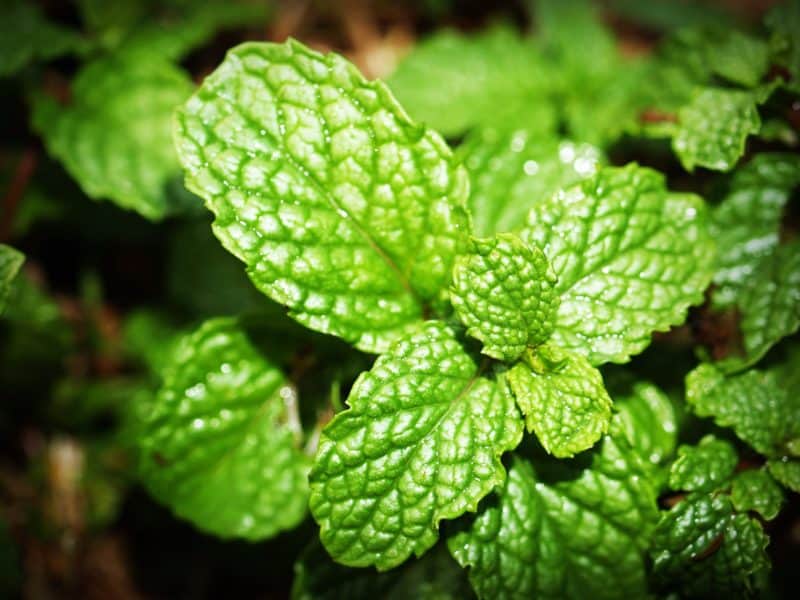
There are a few different methods you can follow for freezing herbs.
1. Individual Stems
The simplest way is to simply freeze your herbs on the stem and then store them in airtight containers. Left on the stem, hardier herbs, like thyme and rosemary, can be spread in single layers on a baking sheet.
Place them in the freezer, and then transfer them into an airtight container once they’ve frozen individually. This will eliminate the likelihood of clumping.
2. In Liquid
You can also freeze your herbs in water or oil. This works best for tender herbs, like parsley, mint, and cilantro. Separate them from the stems and place them in ice cube trays. Cover with water, then put the trays in the freezer.
Once the cubes are frozen, you can pop them out of the tray and put them in freezer bags or containers. You can use them instantly in your cooking with no thawing required, and even in a refreshing mint mojito!
3. Roll-’em
The third potential method of freezing herbs is to roll them. This works best with flat-leaf herbs like sage and Italian parsley. You will need to compress them for this to work, but essentially all you will need to do is remove the stems and fill a Ziplock bag with your leaves.
Compress them into the bottom of the bag, then roll the bag around the herbs. Secure with some twine and place the bundles in the freezer. You can then slice segments later on as needed for your recipes.
Freezing Herbs: A Smart Food Preservation Technique

When you know how to use frozen herbs in your kitchen, you will open yourself up to a whole new world of culinary opportunities. Consider freezing a few sprigs next harvest season, and trust me – you’ll reap the benefits and convenience in winter.
